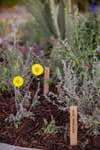A Few Non-Culinary (But Just as Practical) Uses for Your Herb Garden
This landscape artist's new projects engage all the senses.
Published Apr 19, 2022 10:14 AM
We may earn revenue from the products available on this page and participate in affiliate programs.
For Lily Kwong, an herb garden isn’t just a means to a delicious salad. “Before we had CVS and Whole Foods, the forest and the jungle were our apothecaries, our medicine cabinets, our beauty cabinets,” the Los Angeles–based landscape artist points out. Desert marigolds make great fabric dye. Sage is known for its grounding fragrance. Rosemary can be turned into a memory-boosting tincture. “Whether or not you really believe that a certain flower essence is going to help you neutralize grief or find courage, it’s a Pavlovian reminder to connect to that energy,” Kwong adds. In fact, as her new trio of garden projects with JW Marriott proves, you don’t have to harvest anything and you can still reap a plot’s benefits.
“You could use a plant as an object of meditation,” she says. “Take it in, listen. Use it as a tool to sharpen your intuition, your concentration, your mind.” So while the installations will certainly be experimental playgrounds for the properties’ chefs and spa technicians, their primary purpose is simply to encourage passersby to pause, whether to marvel at the plants’ sculptural silhouettes, heady herbaceous scent, or even feel and taste—gently crushing a stem or nibbling on a leaf is very much allowed.
“A garden is a conversation,” Kwong notes, and at the Desert Springs Resort & Spa project (the other two gardens can be found at the Orlando Bonnet Creek Resort & Spa and Essex House New York properties), an exchange can stretch long into the afternoon thanks to the sinuous benches that Kwong’s team built right into the limestone and stucco planters.
On an otherwise unassuming thoroughfare on the shore of the property’s famous lakes, the two kidney bean–shaped structures erupt with native species like milkweed (a remedy for headaches), prickly pear cactus (high in potassium and calcium), and, yes, four types of soothing sage (try steeping them in water for tea). Although the olive trees that dot an undulating path to the nearby spa are still young, Kwong envisions them being another place to sit and reflect in the shade as they grow up to 20 feet tall.
If Kwong’s work has you itching to pick up a trowel, she swears there are also plenty of meditative experiences to be had in your own backyard. “You know, I used to do several thousand–square-foot installations for thousands of people, and then I had a 4-by-4 vegetable bed,” she says, looking back on the COVID-19 lockdown. “I was super-upset, but then I found just as much expansiveness and information by coming to that little plot.” Here, she offers a few words of advice for growing a personal sensory herb garden.
Go Grocery Shopping
Many of the plants in the JW Marriott gardens, like sage (Desert Springs’s signature herb), rosemary (Orlando’s), and mint (New York’s), are available at your local Trader Joe’s. Even better, these varieties are superhardy—the first two, for example, need watering only every couple of weeks. “They can handle an amateur gardener,” says Kwong.
Spread Out
If you’re backyard-less, Kwong suggests a container garden like the one she has off her kitchen—just make sure to plant each of your herbs in separate vessels. Certain ones, like mint, are quick to take over close neighbors.
Match Your Pots to Your Plants
After testing a bunch of swatches, Kwong’s team landed on coating the Desert Springs planters a barely there green. “I got this sage booklet at one of the nurseries that somebody passionately made, and I became really excited because it does well in the desert. We mimicked the color of it,” Kwong explains.
Don’t Be Afraid to Fail
“People feel like if they’ve killed a plant, they’re a bad person or they’ve done something wrong,” says Kwong. “But that’s the way you learn, by trial and error.”











